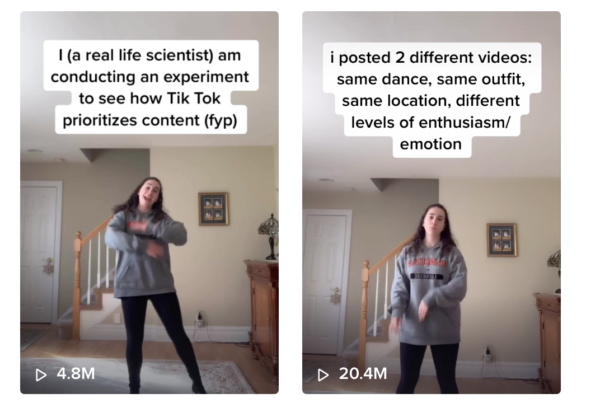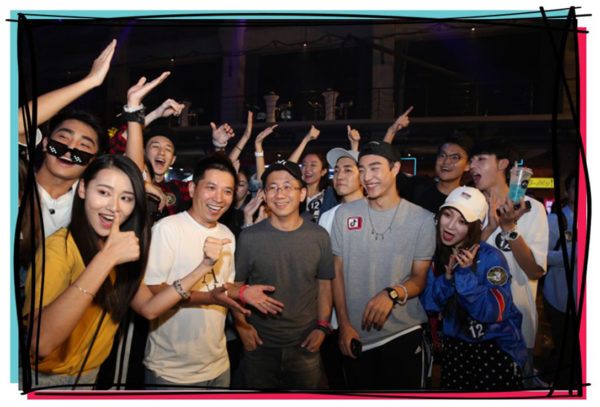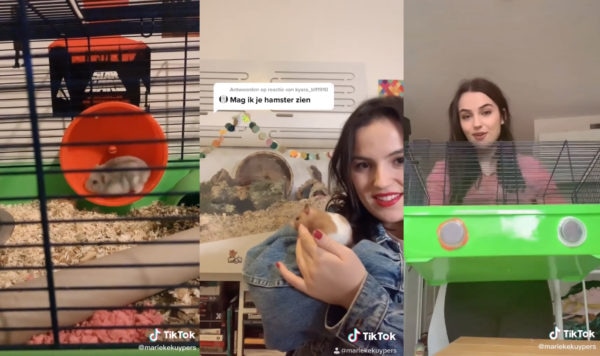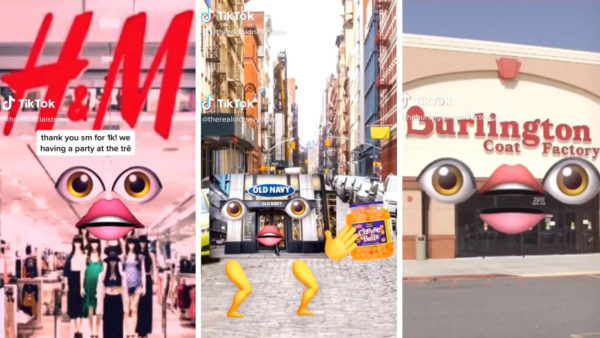When I first opened TikTok in 2018, a world opened up for me. In a very literal sense. The app gave me a glimpse into the intimate worlds of people around the globe. It took me to places that otherwise I would have never seen. A girl from China danced with her daughter, mother, and grandmother through their brightly lit living room. A man from Turkey, sitting on a patterned tiled floor, played a joke on his children. A student from Canada filmed a challenge from behind his desk and, by doing that, gave the whole world a peek into his bedroom. A woman from the United States pulled ice cubes from her huge refrigerator in a kitchen where everything else was huge. And a woman from Jamaica cooked her favourite chicken dish on one burner. Scrolling through TikTok’s For You page, similar to Instagram’s Discover page, made me realise I normally scroll through only a small part of the internet. TikTok showed me that there is much more to discover. It showed me content that would never get into my filter bubble. Around the same time Taylor Lorenz wrote in The Atlantic: “In a world where everyone’s content inevitably begins to look the same, TikTok videos feel bizarre and new. It’s an app full of people posting strange content to the internet with zero self-awareness or shame.” Her description perfectly summarises my experience with the app.
This was two years ago. Now I open the app less often than I would like to. Instead of the app taking me to bedrooms all over the world, I now get videos of puppies, teenagers putting as many Mentos as possible inside a Coke bottle, Dutch people lip-syncing reality star Martien Meiland, and an endless stream of similar content. What has happened in the last two years? Why does TikTok’s For You page show me this content?
The For You page
“TikTok is more machine than man,” wrote New York Times journalist John Herrman in his article ‘How TikTok is rewriting the world‘. The way TikTok works is fundamentally different from the social media platforms that we have become used to. Most of these platforms want you to become a ‘user’ before you can use them. First, you must create a ‘profile’ on Instagram in order to scroll through a collection of photos selected for you. Facebook wants to know which school you went to, so they can introduce you to ‘people you may know’. By collecting as much personal data as possible, the algorithms get to know us, and by knowing us they also know how to make us scroll longer, like more (every like is more data) or buy products.
TikTok works differently. Although there’s the option to create a profile and follow fellow TikTokers, there’s no need to do this in order to use the app. You don’t need to register or create a profile, you can immediately start watching. And you don’t have to connect with friends or ‘like’ things in order to scroll through a personalised feed. Based on your device’s ID the app creates a ‘shadow profile’ that enables TikTok’s machine learning recommendation system to learn from your viewing behaviour. 1 With every video you watch, the system gets to know you better. If you watch a make-up tutorial twice, you get more make-up tutorials in your feed. When you don’t finish a cat video, you get to see less cats on TikTok. Since TikTok is a platform for short video—videos have a maximum length of 60 seconds—users provide the algorithm’ a lot of data about their viewing behaviour in a short amount of time. Based on this data, it creates a personalised feed of content known as the For You page. Because I’m on TikTok to observe and discover things, and not to make content myself, I use the app like this: without an account. Users with an account who are actively interacting with the app, by liking and following other TikTokers, generate even more data. Their For You page may more accurately predict what they might like.
The machine learning recommendation system also offers opportunities for makers. When the algorithm pushes one of your videos by showing it in other people’s For You feeds, it gets a lot more viewers than just your followers. The algorithm doesn’t only push the most popular videos, but also clips with just a few views—which means you can go viral even if you have just a few followers. Only it’s quite unpredictable, since it’s often unclear when, and how, the algorithm chooses to push your video. In a recent blogpost, TikTok says that it relies on a complex combination of factors that are taken into account, such as videos you share, hashtags, or the country settings of your device. This post is the first step TikTok has taken towards being more transparent, as a reaction to security concerns from users and U.S. lawmakers. Although the company gave us some insights about their algorithm, it’s not enough to fully grasp it.

The Chinese start
TikTok is the fastest growing social media app ever. Currently, it has 800 million daily active users worldwide and is the most downloaded app in the App Store. To better understand TikTok’s success and the potential of their algorithm, we need to dive a bit deeper into its Chinese background. Let’s start with Zhang Yiming, the founder of ByteDance which is the parent company of Douyin and TikTok (Douyin is the Chinese version of TikTok). As Matthew Brennan describes in his book Attention Factory (2020), TikTok’s current recommendation algorithm system reflects Zhang Yiming’s personality.2 When Yiming went to university, he didn’t know what to study. He did know that he wanted to go to a well known university, that was situated far away from his hometown, and close to the coast. And he knew that the university shouldn’t be purely focused on science, so that there would be a good gender balance and Yiming could easily find a future partner. Based on those requirements, only one university in China remained: Nankai University, where Yiming studied electrical engineering. His logical and effective way of thinking was the foundation for the smart recommendation algorithms he developed, and that first made him a successful CEO at the Chinese real estate search portal 99Fang.com and later helped him build the Chinese news empire Toutiao. Similar to TikTok, Toutiao serves individual users different news stories based on what the algorithm thinks they’re interested in. Both TikTok and Toutiao are built around a recommendation engine, which is evident when you look at the composition of ByteDance’s employees. Product executive and writer, Eugene Wei writes in his essay TikTok and the Sorting Hat: “Bytedance has an absurd proportion of their software engineers focused on their algorithms, more than half at last check”. In China, ByteDance is known as the algorithm company.

Conquering the world
How could a company with only Chinese developers—most of whom have never left China—get a foot in the door of the Western technology market? How could ByteDance breakthrough with a short video app and leave western technology companies like Facebook or YouTube—that have been operating for years and already have a large network of users—behind in the dust? Their magic algorithm is the answer. ByteDance first conquered the Chinese short video market with Douyin, a clone of the lip-sync app Musical.ly. Musical.ly was also developed in China, but only became popular on the U.S. market. It failed to attract Chinese users because, as Brennan describes in his book, they didn’t have the time to make creative video content. It was only around the holidays, when students didn’t have to study 12 hours a day, that downloads went up.3 ByteDance did manage to make Douyin successful on the Chinese market, by reducing the barrier to make films—by adding face filters and special effects—and by paying art academy students to make cool content. Then, after first copying them, the company bought Musical.ly in order to conquer the Western market. They gave the app a new title and a new logo. They lowered the barrier to consume the content by removing the need to register or log in with an account. They encouraged people to share TikTok videos on other platforms, by showing a ‘share’ button on top of a video once it had looped several times—an indication that the viewer liked that video.4 Besides this free promotion, ByteDance also spent a lot of money on advertisements. But the most crucial change was TikTok’s switch to using Douyin’s backend infrastructure and its sophisticated machine learning technology to be able to personalise the For You feed. The algorithm rapidly learned about the preferences of new users and was very effective in showing them the niche content related to their interests. The users of TikTok got to see the videos they were waiting for, which made them watch more videos. It is said that after switching to Douyin’s backend algorithm, time spent in the app has doubled.5 Being a new and open platform, TikTok opened up opportunities for a new generation of content creators to grow a large fan base without them having to compete with influencers that already have a huge following, as is the case on existing platforms like Instagram. This first group of creative and popular content creators is crucial for starting social media platforms, according to the philosophy of Musical.ly founder and former CEO of TikTok Alex Zhu. Zhu compares building an online community with nation building: “You have to attract immigration, and in order to do so, you’ve got to make a small percentage of people rich first.” 6
The machine learning algorithm is learning so fast and is so effective that the people who developed TikTok didn’t need to know anything about the Western market or their users in order to make their app successful. As Wei writes in his essay: “A machine learning algorithm significantly responsive and accurate can pierce the veil of cultural ignorance. Today, sometimes culture can be abstracted.” This point is worth looking at in more detail. What does the future of our technology look like when machine learning systems entirely determine the content of, and interaction with, our apps? When in China, Wei visited another startup that was working on an Indian news app, while no one in the office spoke Hindi. So, it’s perfectly possible that a future competitor of NU.nl will be made by people who have never been to the Netherlands, let alone speak Dutch or have any idea about our culture.
Gazing into you
With an accurate algorithm that perfectly matches viewers with videos, TikTok is the platform for niche content. Because of the algorithm, even the most obscure niche content reaches a target group and connects people with the same interests. During The Hmm at Tactile Visual Culture, Marieke Kuypers shared how she went viral with a video in which she criticised hamster cages. In her opinion, the hamster cages that are sold in pet shops are way too small. Before she recorded this video, she just had a small following on TikTok. Now over 30.000 hamster fans have subscribed to her channel. TikTok’s recommendation system knows exactly which of their 800 million users would like Marieke’s video.

There are plenty of other success stories. For me, the algorithm actually ensures that I don’t like to scroll through TikTok videos anymore. The following quote from Wei plays a part in this: “When you gaze into TikTok, TikTok gazes into you.” On Facebook we create a profile where we actively share personal information, but TikTok makes that profile just by observing our implicit behaviour. TikTok can thus characterise us without us introducing ourselves first. This not only makes it even less clear what data we give away, it’s also difficult to change the image that TikTok has made of us. One reason that I don’t like my For You page anymore is due to the excessive number of dog videos. After noticing that, I realised that TikTok might think I like dog videos because I did send some to my sister, a dog lover. I didn’t like the videos myself so much, but I thought my sister would appreciate them. By doing that, I had shown the wrong side of myself to the TikTok algorithm.
After the wow-feeling I got in the beginning when opening the TikTok app, I’m back into a filter bubble. Only this time it’s not one that I (kind of) chose myself, but one TikTok has put me in. A friend had a similar experience. After spending a few nights scrolling through TikTok, she got a lot of videos from people who shared their social problems. Another friend removed the app after seeing too many beautiful people dancing. It’s good to mention here that the For You page is not completely curated by the algorithm, it is also controlled by content moderators. In March 2020, The Intercept reported that TikTok instructed content moderators to suppress content of ‘ugly people’ to attract new users. In my friends case, it has the opposite effect. (Now I’m wondering why the dancing people in my For You feed are not always pretty at all. What does it say about my viewing behaviour?)
Not for you
Every For You page is different. As a result, I often get the feeling that I missed something when I hear others talk about TikTok. Via Twitter, I learned about the movement Elite TikTok, a backlash to the lip sync- and dance videos TikTok is full of. Elite TikTok is not one account or a hashtag, but a style. All videos in this style are a bit crazy. Instead of brands or material assets, users are obsessed with frogs, beans, and weird visuals. If this was something on Instagram, you could subscribe to an Elite account or follow some Elite creators, but on TikTok doing this doesn’t mean your For You page is immediately filled with Elite TikTok content. You have to actively train the algorithm. As Matilda Boseley and Ben Doherty write in their article ‘What is Elite TikTok and what has it got to do with Donald Trump?‘: “There is no way to ‘find’ Elite Tiktok, you just have to be strange enough, or cool enough that the videos you like and spend time on will mean the algorithm will let you into this exclusive club.”

Artist Ben Grosser had a similar experience. While browsing on TikTok he noticed that the algorithm narrowed his field very quickly. He kept seeing the same kinds of videos over and over again, and started wondering if that’s all there was or that this was all that TikTok wanted to show him. It turned out to be that second option. When I asked Ben about it, he told me: “I think the fabled For You AI algorithm being better than anything else out there at understanding what the user wants to see is a bit of a myth. The For You algorithm, like the News Feed on Facebook, is not designed to give users what they want—it’s designed to keep users on TikTok. As we’ve seen with other platforms like Facebook, when what users see is determined by an algorithm designed to keep them engaged, the results can be catastrophic.” TikTok’s censorship of ‘ugly’ people is a good illustration of this. Ben came up with a solution that ensures the users’ viewing behaviour is not dictated by TikTok: his project Not For You, an automatic confusion system intended to fool TikTok’s recommendation algorithm. By downloading the extension, the algorithm forgets who you are for a moment. You get to see the nooks and crannies of TikTok that content moderators, or the algorithm, prefer not to highlight, but that we as users may find exciting. As Ben describes on his website: “Not For You is making it possible to see how TikTok feels when it’s no longer made For You”.
TikTok is entertaining people from all over the world with short videos, and there is more to come. The Chinese version of the app Douyin is now expanding its focus to education and retail. The app took the world by storm because of its fast learning gazing machine. But the algorithm only works for users who like watching similar content over and over again. To see different people do the same dance to the same song. Or to see different people putting as many Mentos as possible into a Coke bottle. The algorithm is addictive because it continually shows you what you like, or what you think you like, but it works counterproductively for users like me, who are on TikTok to discover things. What Ben said rings true, that all algorithms on all social media platforms are not made for users who want to discover things. Yet other social media platforms are less surprising. When you login to Instagram you will see content based on your friends’ posts. The YouTube homepage only shows viral videos. On TikTok’s For You page you can also scroll through videos that only have 7 views. When I first downloaded the app, TikTok gave me a unique look outside my filter bubble. Hopefully Ben’s Not For You extension could bring me back to my TikTok addiction.
References